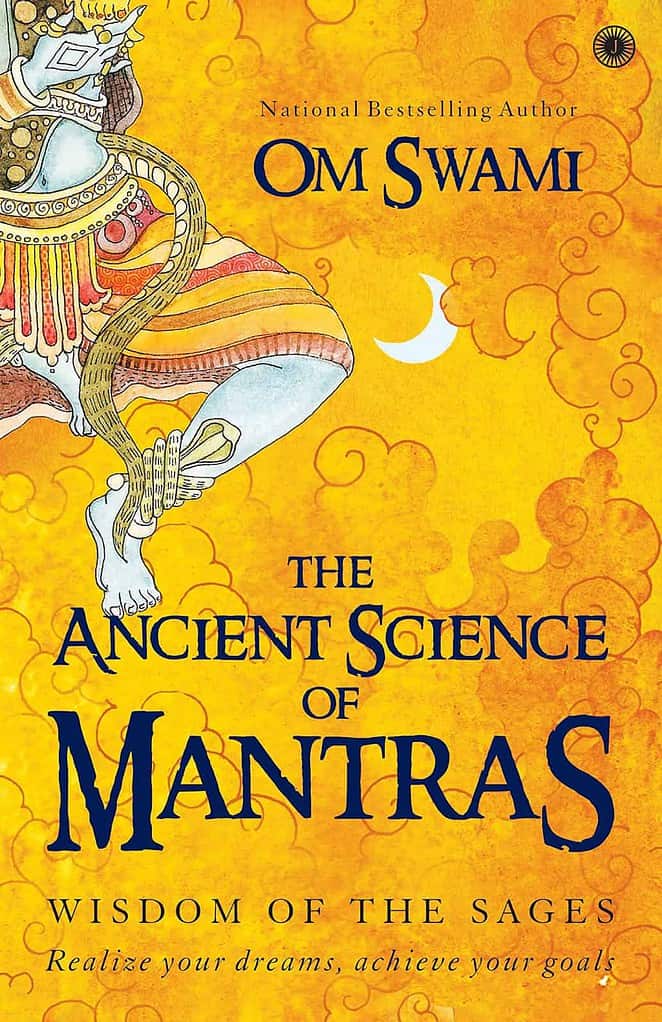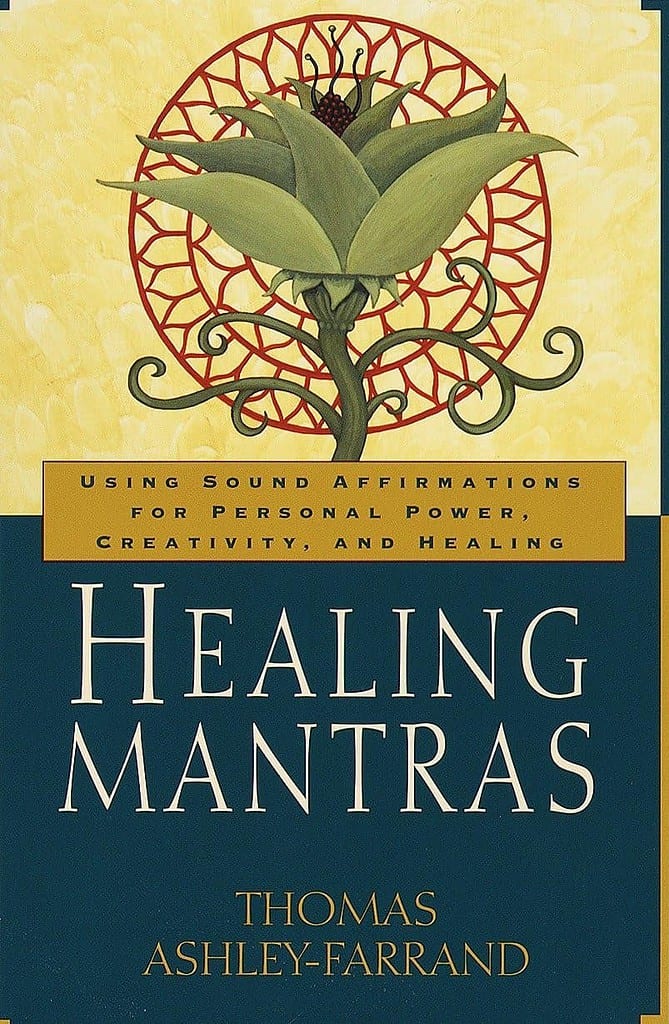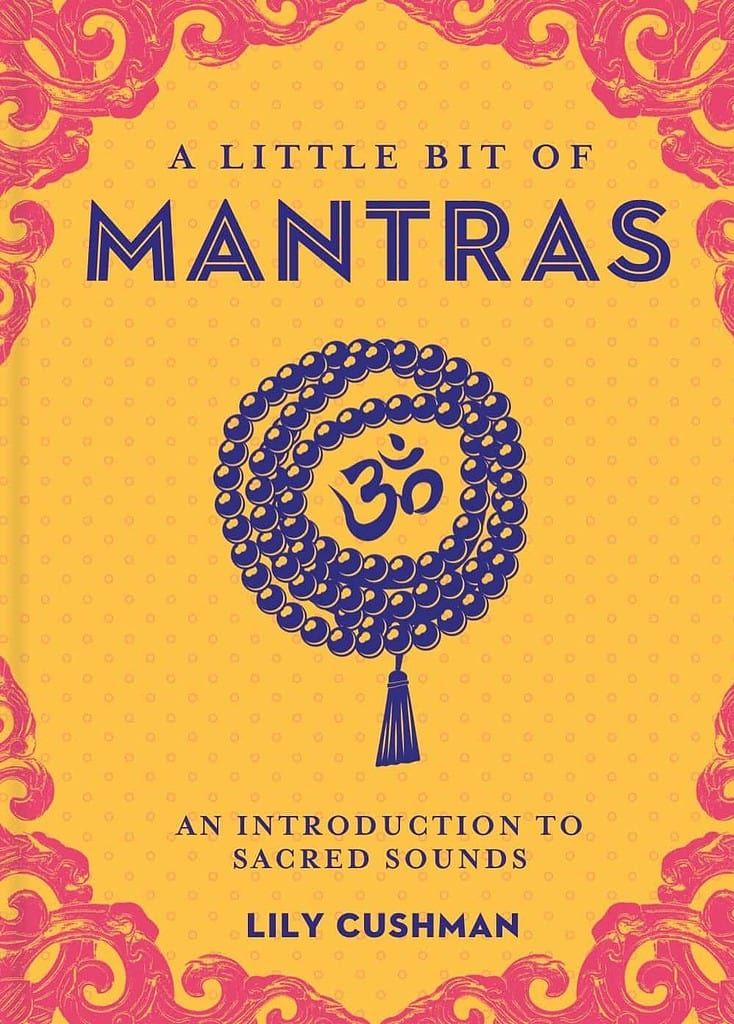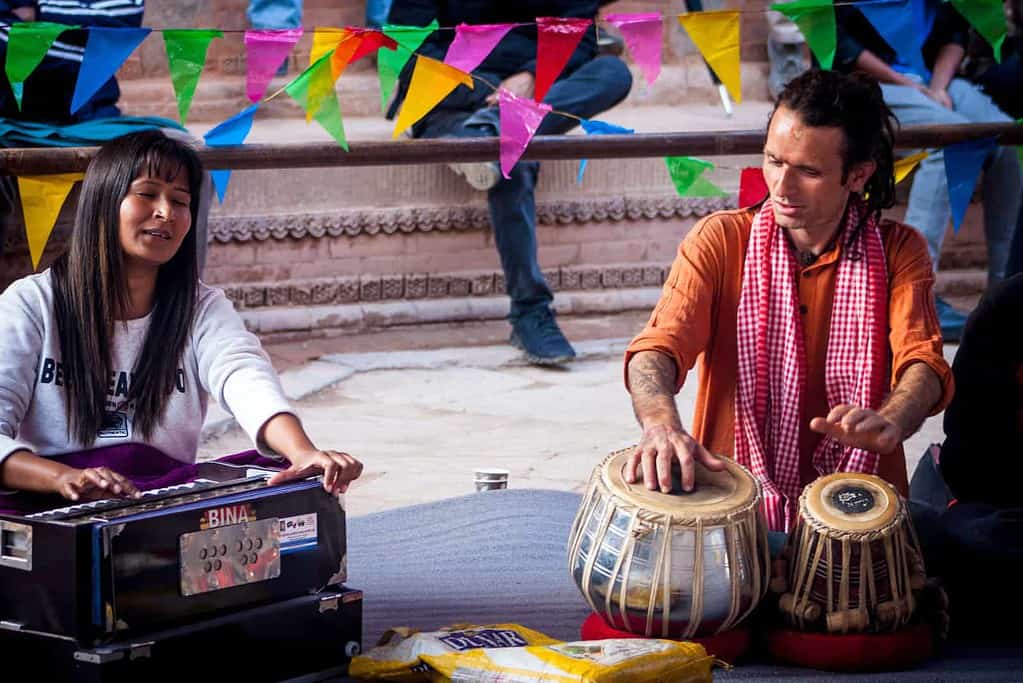Yoga Mantra 101 – The Ultimate Guide To Yoga Mantras
The post <strong>Yoga Mantra 101 – The Ultimate Guide To Yoga Mantras</strong> appeared first on The Yoga Nomads.

An iconic part of a yoga class is chanting Om. However, many beginner yogis don’t realize that Om is just one of the many sacred Sanskrit words you can chant during yoga practice. What’s more, each yoga mantra creates a unique effect on your psyche.
Mantras are not an aspect of yoga that you learn much about in a typical drop-in yoga class. You may chant one, but you likely won’t learn its meaning. However, mantras are a vital part of yoga; thus, every avid yogi should take some time to study these sacred sounds.
In this guide, I’ll explain what mantras are and why they are used. I’ll then share nine common mantras you may hear in a yoga class and share my favorite books on mantras so you can deepen your knowledge further.
What Is A Yoga Mantra?
A yoga mantra is a sacred word or series of words chanted silently or out loud to invoke various spiritual qualities. Mantra is a Sanskrit word that translates to “mind tool” or “mind instrument.”
In yogic teachings, it is believed that chanting mantras in yoga and meditation practices can help you progress along your spiritual path toward liberation. This is because mantras are not simply words; they are symbolic, sacred sounds with potent spiritual healing powers.
Yoga mantras are all derived from the Ancient Sanskrit language. While each mantra has a particular meaning, it’s the sound the mantra creates that makes it so potent.
What Is Mantra Meditation?

Mantra meditation is a technique that uses mantras to quieten and relax the mind and help you cultivate focus to have a more profound meditative experience. There are two types of mantra meditation; Japa and Kirtan.
Japa meditation involves chanting the same mantra repeatedly using prayer beads to track how many repetitions you do. Traditionally, Japa yoga teachers believe you should do 108 repetitions in each practice (as 108 is a sacred number). However, starting with a smaller number of rounds is fine when you are learning the technique.
You can do Japa meditation out loud, whispering, or silently in your mind. Additionally, as it/s a simple technique, you can do Japa while seated or performing yoga postures.
Kirtan meditation is a congregational practice performed as a ritual as part of the Bhakti yoga lineage (the yoga of devotion). During a Kirtan session, you’ll chant different mantras in a call-and-response style as the facilitators use various musical instruments.
The purpose of Kirtan is to open your mind to supreme wisdom and connect with the universal consciousness. It also has some compelling mental benefits, such as increasing your mood and energy levels and lowering feelings of stress and anxiety.
A similar style of meditation is Transcendental Meditation, a practice created by Maharishi Mahesh Yogi in the mid-1950s. This technique also involves repeating a sacred phrase. Traditionally, the teacher gives each yoga practitioner a personal mantra to chant. This is because it is believed that every person has a specific mantra that will work best for them.
Best Books To Learn About Yoga Mantras
While this guide will provide a complete overview of yoga mantras, I suggest reading one of the following books if you want to further study these sacred sounds.
The Ancient Science of Mantras By Om Swami

Hands down, the best book for learning about the history of mantras is The Ancient Science of Mantras: Wisdom of the Sages by Himalayan ascetic Om Swami. This book will teach you so much, including where mantras come from and their relevance in today’s world.
Through a series of thought-provoking yet easy-to-read sadhanas, you’ll understand how to invoke the mystical energy of mantras for both material and spiritual fulfillment. Om Swami shares his in-depth knowledge on this subject through anecdotes, personal experiences, and humor, keeping you engaged on every page.
Om Swami also shares specific routines prescribed in the Vedic scriptures, making you feel like you are accessing hidden wisdom from the ancient sages. It’s an excellent choice for yogis and spiritual seekers of all levels.
Healing Mantras by Thomas Ashley-Farrand

Healing Mantras is a short yet in-depth book on the powerful applications of sound. Author Thomas Ashley-Farrand offers a practical approach using this ancient yogic practice in the modern world.
As one of the few Western experts in Hindu and Buddhist mantras, Thomas Ashley-Farrand can effectively introduce the concept of Sanskrit mantras to westerners unfamiliar with eastern religions. He also breaks down the pronunciation of the mantras into easy-to-follow phonetic symbols.
Because of its straightforward, accessible style, this book is perfect for those who are just getting into spirituality and are still skeptical.
A Little Bit of Mantras by Lily Cushman

A Little Bit of Mantras is a fabulous pocket-size guide on working with sacred sounds. Thanks to the incredibly fresh and accessible style of writing by author Lily Cushman, you’ll quickly understand a great deal about mantras with no feelings of confusion.
It includes chapters on the history, benefits, and application of mantras. It then splits Sanskrit mantras into categories based on their purposes, such as healing, peace, or strength. This makes it an excellent reference book for using in your yoga practice. You can pick it up and flip to the mantra that is most relevant to you.
As it’s a light read and a small size, this book is perfect for reading while traveling or commuting. What’s more, it includes an audio practice recorded by the author.
Benefits Of Chanting Mantras In Yoga Practice

Sanskrit mantras don’t just sound beautiful; chanting them has many benefits for the mind and spirit, such as:
Increased focus
Suppose you find it hard to concentrate and have what the Buddhists call a “monkey mind” (overactive mental activity). In that case, you’ll surely benefit from chanting mantras. Many meditators find this style of meditation preferable as it’s easier to focus on a sound they are making rather than their breath. This is because when you chant mantras, all your awareness is on that, preventing your attention from wandering in other directions.
Increased mindfulness
Chanting a mantra brings you into the present moment, reducing the amount you worry about the future or playing past events in your mind. Repetitive chanting can also get you into a profoundly relaxed flow or trance-like state where your full awareness remains in the moment and, specifically, in your body.
Improved cognitive function
A study on Kirtan meditation found that mantra chanting increased cerebral blood flow and cognitive function in the participants’ minds. What’s so interesting about this is that the results came from chanting for just 12 minutes every day for 8 weeks. This shows that you don’t have to spend hours chanting every day for years before you can experience the beautiful benefits.
Stress Reduction
If you often find yourself feeling stressed, starting the day by chanting mantras will make a massive difference to how you feel in daily life. A 2017 study on mantra meditation found the practice effective at synchronizing the left and right sides of the brain. This promotes relaxing (alpha) brain waves, which calms the mind and reduces stress and anxious thoughts.
Heightened Self Realization
Regular mantra meditation can help you connect deeper to your inner self and discover your true nature. This is because your mind becomes clearer and more present, allowing you to self-reflect. In addition, as you access higher vibrational frequencies when you chant, you raise your vibration. Higher vibrations will enable you to move past the human form and connect with your higher self and the entire universe.
9 Common Mantras Used In Yoga & Meditation Practice

If you want to start using mantras, try a few of the following yoga practice mantras, choosing the ones that most resonate with you.
Om Mantra
You don’t have to be a seasoned yoga practitioner to know the Om mantra, as Om is the most famous mantra in yoga and meditation practice. Om is known as the sound of the universe, as it was the first sound heard when the universe was created.
It is believed that chanting Om creates a vibrational frequency of 432 Hz, the same frequency found throughout nature. As a result, the Om mantra has a highly calming effect on the brain and nervous system and, thus, helps to settle the mind ahead of your spiritual practice. In addition, when you chant Om, a specific healing vibration runs through your vocal cord, which helps to clear and open up the sinuses.
Om is pronounced as A-U-M, and it is essential to chant it as three syllables. It should sound like “AaaahooohMmmm” with the Aaaaah’ produced from deep in your throat. Then, gradually shift to “oooh” using the middle part of the mouth and end with “Mmmm” through the front part of the mouth and the mouth closed.
Sat Nam Mantra
Sat Nam translates to “whose name is truth” or “truth is my identity.” Sat means truth/ honesty, and Nam means name/identity. Thus, chanting Sat Nam can help you break free from false or limiting beliefs, access your highest truth, and uncover your true identity.
Sat Nam is one of the most common mantras used in Kundalini yoga. So how do you pronounce it?
Firstly, Sat rhymes with but rather than bat, and Nam rhymes with mom rather than mam. Then, when chanting Sat, touch your tongue to the roof of your mouth when pronouncing the ‘t”. Finally, draw the sound up from your navel through your heart and throat to the top of your mouth.
Hare Krishna (Maha Mantra)

The Hare Krishna mantra, also known as the Maha-mantra, dates back to the 15th century when it was mentioned in the Kali-Santarana Upanishad. This mantra connects you to a higher power known as Krishna consciousness and is frequently chanted among Bhakti yogis.
The 16-word mantra goes as follows:
“Hare krsna hare krsna krsna krsna hare hare
Hare rama hare rama rama rama hare hare”
Hare means the beautiful energy of the Lord, Krishna means the all-attractive one, and Rama means the one who gives happiness to all.
Gayatri Mantra
The Gayatri Mantra is one of the oldest and most potent Sanskrit mantras. It comes from the Vedas and has been cited in other Hindu texts like the Bhagavad Gita, Harivamsa, and Manusmṛti.
Gayatri Mantra is dedicated to the sun god, and it is believed that chanting these words can bring you happiness and wisdom. It goes as follows:
“Om Bhuur-Bhuvah Svah
Tat-Savitur-Varennyam
Bhargo Devasya Dhiimahi
Dhiyo Yo Nah Pracodayaat”
In English, the Gayatri mantra loosely means:
“We meditate on the adored Supreme Lord, the creator, whose divine light illumines all realms (physical, mental and spiritual). May his divine light illuminate our minds”.
Om Namah Shivaya Mantra
The Om Namah Shivaya mantra means “O salutations to the auspicious one!” or “adoration to Lord Shiva.” It is dedicated to the Hindu god Shiva and consists of five syllables, each relating to one of five elements. Na represents earth, ma refers to water, si is fire, va is air, and ya means ether, which together means universal oneness.
Like others, the Om Namah Shivaya mantra helps you connect to your higher yourself and disconnect from the ego. It can also remove troubling thoughts from your mind and show you the right path.
Lokah Samastah Sukhino Bhavantu

Also known as the universal peace mantra, this beautiful phrase means:
“May all beings everywhere be happy and free, and may the thoughts, words, and actions of my own life contribute in some way to that happiness and freedom of all.”
Breaking down the Sanskrit words, Lokah means realm or all universes existing now, and Samastah means all beings in the same place. Sukhino means happiness, joy, and free from suffering, and Bhav means the divine mood or state of unified existence. Lastly, Antu means may it be so – it is used at the end as a powerful pledge.
Adi Mantra
The Adi Mantra consists of the Sanskrit words “Ong Namo Guru Dev Namo,” which translates to “I bow to the Creative Wisdom, I bow to the Divine Teacher within.” The Adi mantra helps you connect to the universe as it provides direct access to higher consciousness. It is also known to awaken your intuition and creativity and give awareness and guidance.
‘Adi’ means primal, and chanting this mantra allows you to tap into the most elementary energy and frequencies. This allows you that hear, see, feel, do and be more. The first word, “Ong,” translates to Creative Energy, “Namo” means to bow with an open heart and willing mind, and “Guru dev” refers to your inner knowing.
Om Shanti Mantra
The Om Shanti mantra, also known as Om Peace (as Shanti means peace), invokes peace and the end of suffering. Shanti is typically chanted three times like Om Shanti Shanti Shanti Om. This represents threefold peace in the body, mind, and spirit.
In addition, the first Shanti is to send peace to yourself, the second is to send peace to your loved one, and the third is to transmute peace to the whole universe. This mantra helps you connect to your heart and the Anahata chakra, cultivating more love, compassion, and empathy.
Maha Mrityunjaya Mantra
The Maha Mrityunjaya Mantra, also known as the Rudra Mantra, comes from the Rig Veda and is considered the most potent Shiva Mantra. The mantra’s name translates to “The Great Victory over the Great Death.”
It is believed that chanting this mantra can remove obstacles and fear and cultivate healing and longevity. It is particularly beneficial to use during distress, challenges, and failure.
The Maha Mrityunjaya Mantra goes like this:
“Om Tryambakam Yajamahe Sugandhim Pushti-Vardhanam
Urvarukamiva Bandhanan Mrityormukshiya Mamritat”
There are many different translations of this mantra. Still, it loosely means, “We worship the Trinetra, which is fragrant and nourishes us. Just as the fruit is liberated from the bondage of the tree, may we also be liberated from death and impermanence.”
Mantras & The Seven Chakras

Each of the seven chakras has a one-syllable mantra associated with it. It is said that chanting a specific chakra’s mantra can help to release blockages and stagnated life force in that energy center. This, in turn, can help you connect to the chakra’s qualities and draw strength and healing from it.
The chakra mantras are:
Root Chakra – LamSacral Chakra – VamSolar Plexus Chakra – RamAnahata Chakra – YamThroat Chakra – HamThird Eye Chakra – AumCrown Chakra – Om or silentFor the first five chakra mantras, emphasize the “a” when chanting, such as L-A-A-A-M.
Tips On Practicing Mantras

Here are some helpful tips if you’re looking to introduce mantra chanting to your meditation or yoga practice.
Start With Shorter Mantras
If you’re practicing mantras for the first time, choose one with just a few words, such as the Om or Sat Nam Mantra. This will allow you to get used to the technique without getting lost and confused.
Learn The Correct Pronunciation
The correct pronunciation is essential to maximize the benefits of chanting a mantra. This is because the way it is pronounced and the exact sound determine the vibrational frequency it creates. Therefore, it’s best to consult an experienced yoga teacher or trustworthy online learning sources for pronunciation guidance.
Use Mala Beads To Count Repetitions
Some traditions teach that you should repeat a mantra 108 times. Whether you aim for this many or less, I recommend using mala beads to keep on track. As well as tracking your repetitions, using mala beads further increases your focus, serving as a handy meditation tool.
Mala beads can come in different materials and styles. I like these Crystal Beads by PNEIME as you can choose the gemstone you want, such as green agate, amethyst, or turquoise. As crystals have unique qualities, using mala beads like this one can increase the benefits you receive.
Wood mala beads are a more traditional option, like the ones from Anzhongli. Choose between sandalwood, rosewood, tigerwood, and others.
Combine Them With Mudras
Once you have a comfortable mantra practice, consider introducing mudras (hand gestures) into your chanting. Mudras have specific meanings and benefits; thus, they pair nicely with mantras, making the effects more powerful. I found this Mudra Card Deck a fun and interactive way to learn about the different mudras and their benefits.
Final Thoughts On Yoga Mantra
Mantras are powerful tools; they can help you cultivate focus, joy, compassion, or calm and connect to your inner being and universal energy. Now you know some commonly used Sanskrit mantras, why not use them in your spiritual practice and experience the magical effects for yourself?

 ShanonG
ShanonG 






























